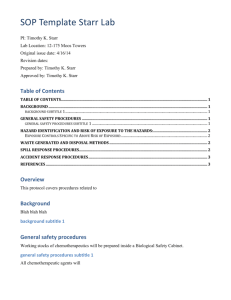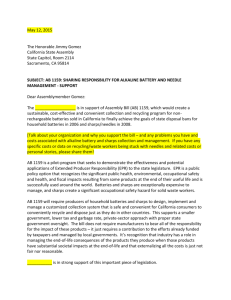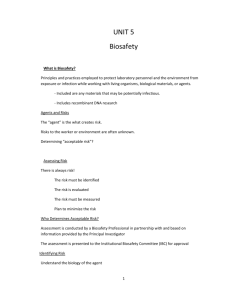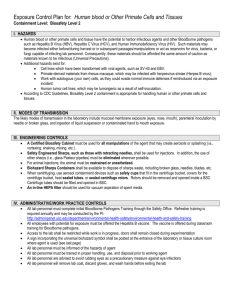Section I: Emergency Contacts and Lab Members
advertisement
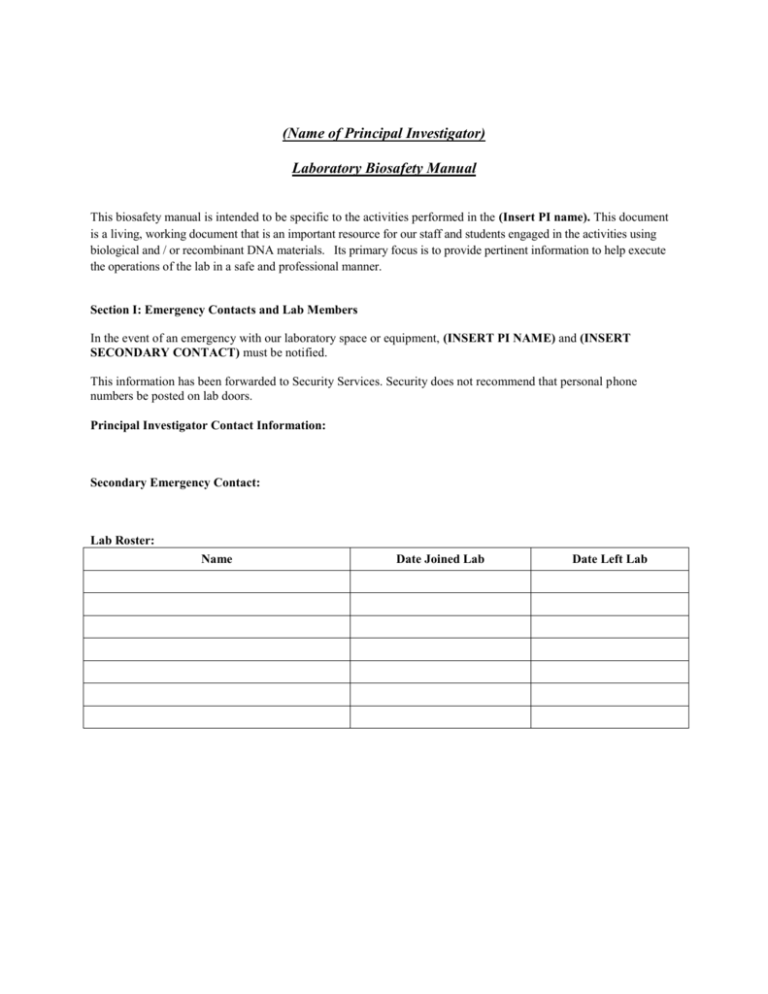
(Name of Principal Investigator) Laboratory Biosafety Manual This biosafety manual is intended to be specific to the activities performed in the (Insert PI name). This document is a living, working document that is an important resource for our staff and students engaged in the activities using biological and / or recombinant DNA materials. Its primary focus is to provide pertinent information to help execute the operations of the lab in a safe and professional manner. Section I: Emergency Contacts and Lab Members In the event of an emergency with our laboratory space or equipment, (INSERT PI NAME) and (INSERT SECONDARY CONTACT) must be notified. This information has been forwarded to Security Services. Security does not recommend that personal phone numbers be posted on lab doors. Principal Investigator Contact Information: Secondary Emergency Contact: Lab Roster: Name Date Joined Lab Date Left Lab Section II: Biological Agent Information The following biologicals are found in the (INSERT PI NAME) Lab. The ways in which these agents may be transmitted to humans in a laboratory setting are listed under Laboratory Risks. In order to protect yourself and others from infection with these agents, you are required to conduct your research using a certain set of biosafety precautions. These precautions are correlated with the agent under the headings BSL (for biosafety level) and ABSL (for experiments involving live vertebrates). A copy of the biosafety precautions is found in the next section of this manual. Contact (INSERT PI NAME OR LAB MANAGER NAME) with your questions. Biological Agent Laboratory Risks BSL Instructions for completing the table: In this section, correlate the biological agents possessed with the laboratory risks of working with the agent and the biosafety level used in your laboratory. You may list agents individually or group them according to the biosafety level. Animal Biosafety Levels (ABSL) are precautions used for experiments involving live vertebrate animals. Laboratory risks must reflect methods of transfer for the diseases associated with your biological agents. For example, human cell lines may harbor adventitious viruses, which may be transmitted through sharps injuries, contact with broken skin or mucous membranes. Animal bites or scratches may transmit certain agents. If an agent does not present a hazard then indicate as such. Add more lines to the table as needed. Resources: UR Laboratory Biosafety web pages CDC / NIH “Biosafety in Microbiological and Biomedical Laboratories” NIH Guidelines Appendix B Health Canada MSDS for Infectious Agents American Biological Safety Association Risk Groups ATCC searchable catalog ABSL Section III: University Biosafety Requirements Insert applicable set(s) of university requirements based on biosafety level (s) applicable for the laboratory research. (Biosafety Requirements and Resources) Section IV: Medical Surveillance The University of Rochester offers several vaccines and tests to its employees and students depending on the research being pursued. The forms of medical surveillance offered to the members of the (INSERT PI NAME) Lab are listed in the table below. If you have not been offered these vaccines or tests, contact (INSERT PI NAME OR LAB MANAGER). Individuals at increased risk of infection (e.g. pre-existing disease, medication, compromised immunity, pregnancy or breastfeeding) may seek confidential job-related risk counseling through University Health Services Occupational Health Program. Individuals having these conditions should self-identify to the University Health Services. Hepatitis B Vaccine Series: This vaccine series must be offered to all lab employees who work with hepatitis B virus, human blood, body fluids, and tissues; primary human cells; and human cell lines (including established lines). Contact University Health Services Occupational Health Program (x54955) for assistance in formally offering (or declining) the vaccine as well as for vaccine administration, and record keeping. Refer to the Hepatitis B Vaccine Fact Sheet for more information. Vaccinia Virus Vaccine: This vaccine must be offered to laboratory employees working with vaccinia virus. Please refer to Vaccinia Virus guidance for additional information; a declination form is online and must be completed if individuals decide to forgo this vaccine. Contact University Health Services Occupational Health Program (x54955) for assistance in formally offering and declining the vaccine, vaccine administration, and record keeping. BSL-3 Medical Surveillance Program: subject to change. Contact Biosafety Officer (x53014) or BSL-3 Director (x54670) for details. Applies to BSL3 / ABSL3 facility users only. Serum Banking: This option is offered to lab employees working with certain human pathogens. Refer to the Serum Banking guidance for additional information. Note that serum banking is NOT recommended or supported for routine work with HIV, HCV and HBV (common bloodborne pathogens). It is recommended only in limited, specific instances described at the above web site. Seasonal Influenza Vaccine: This vaccine series is highly recommended for laboratories working with any influenza virus. The vaccine can be obtained during seasonal offering. The seasonal influenza vaccine may not prevent infection with strains used in laboratory research, but may help eliminate potential sources of infection in the event laboratory workers develop “flu-like” symptoms. Not Applicable. Please note that if you check this box and are using human cell lines, you will be asked to provide certification that the lines have been found to be free of human pathogens. Instructions for completing the table: Check the applicable box and ensure that the information matches Section V of the IBC Laboratory Registration Section V. Resources: Hepatitis B Vaccine Fact Sheet Serum Banking Vaccinia Virus Vaccine Section V: Personal Protective Equipment. In the (INSERT PI NAME) Lab, personal protective equipment (PPE) is required for handling hazardous materials. The required PPE has been correlated with the biological agent and the task. If the PPE for each task with a particular agent is the same, then ‘ALL’ is noted under ‘Tasks’. Biological Agent Personal Protective Equipment (e.g. nitrile or latex gloves, lab coat, gown, face shield, mask, safety goggles, shoe covers, etc.) Add more lines to the table as necessary. Task (List specific tasks or ‘ALL’) Section VI: Emergency Procedures Trained personnel must clean all spills of hazardous materials. In the (INSERT PI NAME) Lab, persons qualified to clean up spills are listed in the table below. Biological spill procedures are included in this section. All spills must be reported to (INSERT PI NAME OR LAB MANAGER). Spills that may have resulted in personnel exposures must also be reported to the Biosafety Officer (X5-3014) and documented using the University Employee Incident Report. Incidents that may result in exposure to potentially hazardous materials including recombinant DNA and unfixed animal tissues must be immediately evaluated through University Health Services Occupational Health Unit. To accomplish this, the following actions must be taken: All incidents, exposures, potential exposures, and recognition of signs and symptoms of a disease-causing agent used in the lab or that may be found in unfixed animal tissues (experimental or zoonotic disease agents) must be reported to (INSERT NAME OF PI OR LAB MANAGER). (INSERT NAME OF PI) must report this information directly and immediately to the UR Institutional Biosafety Committee. A University Employee Incident Report must be filed. UR Employee Incident Report Persons qualified to clean-up spills Disinfectant Name Dilution Location in Lab In this section insert: Procedure for spills and centrifuge accidents (template provided at the end of this document) o List effective disinfectants and their location in the lab Biological Exposures o First aid measures (template provided at the end of this document) o Known resistance traits of organisms (natural or introduced) o Signs and symptoms of disease Add more lines to the tables as necessary. Section VII: Aerosols Generating Procedures Many procedures generate biological aerosols, which may be released and lead to contamination of the laboratory and / or disease transmission. In the (INSERT PI NAME) Lab, we control this risk using the following equipment and practices. Contact (INSERT PI NAME OR LAB MANAGER) with your questions. Task Aerosol Control Measures Sonication Homogenization Tissue grinding Blending or mixing Other: Instructions for completing the table: Complete this table by checking the applicable boxes and completing the corresponding information. A list of the aerosol generating procedures and the control measures can be found in Section VII of the IBC Laboratory Registration. Add more lines to the table as necessary. Section VIII: Procedures The University of Rochester Department of Environmental Health and Safety and the Institutional Biosafety Committee provide many safety guidance documents for laboratory researchers through the Internet. Please insert as applicable to your lab. Biosafety Requirements & Resources Environmental Health and Safety Some suggestions are provided below. Tissue Culture Practices and Procedures Sharps Safety (template provided at the end of this document) Lab Waste Disposal Transportation within University Building Procedures for Using Viral Vectors (if applicable) Experiments involving unfixed non-human primate tissues or fluids (if applicable) Flow Cytometry Biosafety Requirements (if applicable) Section IX: Security Provisions Laboratories are locked when unattended. Long-term storage units (refrigerators, freezers, cryo units) containing potentially hazardous materials, which are located in shared equipment areas or outside laboratory areas, must be locked and labeled. Hazardous materials must never be left unattended in public access areas such as corridors. Environmental rooms (cold room or warm room) must be locked when experiments involving potentially hazardous materials are in progress and left unattended. Access to potentially hazardous materials including recombinant DNA is restricted to trained individuals at the discretion of the Principal Investigator. Suspicious behavior or individuals who do not belong must be reported to Security Services at X13 and to (INSERT PI OR LAB MANAGER NAME). Section X: Training All laboratory personnel must participate in lab training. In the (INSERT PI NAME), the following training is required. Environmental Health and Safety’s Lab Safety Training: Everyone is required to complete the (INSERT TRAINING TYPE), which is available at this web link Lab Safety Training . When you have finished completing your quiz, submit it to (INSERT PI OR LAB MANAGER NAME). List other training as applicable. Some examples include Radiation Safety Training and UCAR Training. Records of appropriate training (technical, safety, etc.) of lab personnel should be included in this biosafety manual. If not, these records must be available for review by regulatory and compliance personnel. A Compliance Checklist Template is provided at the end of this document. Section XI: University Approvals In this section place: Institutional Biosafety Committee (IBC) approval letters University Committee on Animal Resources approval letters including Safety reviews from Environmental Health and Safety Research Subjects Review Board (RSRB) approval letters Section XII: IBC Registration Support Documents In this section place: IBC Laboratory Registration IBC Viral Vector Registrations IBC inspection results Emergency Plan: Biohazards Centrifuge Spill: 1. Spill in Centrifuge with safety caps: When centrifuging BSL-2 materials, safety caps for centrifuge buckets must always be used. The safety bucket will act as secondary containment, and should only be opened under containment, in the biosafety cabinet. If there is a release of fluid, any aerosols will be contained, and the safety buckets can be easily decontaminated with X disinfectant. Also clean the inside of the centrifuge with X disinfectant. 2. Spill in Centrifuge without safety caps: Aerosol containment can be achieved by closing the lid of the centrifuge. After 30 minutes, spill should be cleaned by covering it with paper towels and applying X disinfectant. Spray the product on and leave on surface X minutes. Dispose of the paper towels, etc, into the red bag waste. Do NOT use bleach on the centrifuge rotors! Spill Outside of Containment (outside of Biosafety Cabinet): CLEAN-UP: 1. Did you cut yourself during the spill, or splash uncovered skin (was this skin broken or abraded?)? If the answer to any of these questions is yes, you will need PROMPT medical attention (wash your skin & contact UHS at x5-1164). 2. If you are unable to clean up the spill (i.e., alone or injured), call Security at x13. Security will contact EH&S for cleanup. Remain available to provide Security and EH&S with information. 3. Close the lab door, notify other laboratory members of spill and ask them to leave the immediate area. Post a sign on the access door to this area indicating that there is a biohazardous spill and people should stay out of the area. 4. Put on protective clothing. Wear double gloves, a lab coat and face shield. Make sure all exposed skin is covered – Protect Yourself. Get some red biohazard bags. 5. Pick out any broken glass or sharps objects with tongs or forceps. Discard these sharp items in a sharps shelter labeled with a biohazard sign. 6. Place Disinfectant-soaked paper towels over the spill. Then carefully pour disinfectant over the towels and leave it to stand for X minutes. Discard the towels into the red biohazard bag & clean area repeatedly with X disinfectant. AFTER A SPILL: 1. File an incident report: Online form at UR Employee Incident Report Form 2. Consult University Health Services (x5-1164) concerning the incident and possible exposure. Do NOT DELAY in seeking medical attention in the event you cut yourself or exposed broken skin. AFTER HOURS: 1. Call University Health Services for medical attention (x5-1164). There is a hotline information tape. 2. Call PI and/or Supervisor, XXX-XXXX. General Sharps Safety Policy NEVER PUT ANY SHARPS INTO THE REGULAR TRASH. EVER! GLASS ITEMS (intact and broken) contaminated with biohazardous materials, such as blood tubes, pasteur pipettes, microscope slides, cover slips, etc, MUST be disposed of as SHARPS WASTE A document that is helpful to determine how to properly dispose of laboratory waste, including sharps, is located on the EH&S website at: Lab Waste Table Every effort should be made to reduce the use of sharps, such as needles, glass pipettes, scalpel and blades, especially when handling dangerous chemicals or biohazardous agents. If possible use: Blunt needles (DO NOT need the point of a traditional “pointy” needle) Safety needles (DO need the point of a traditional “pointy” needle). Safety needles have a safety device that is integral with the needle; allowing for covering of the needle without recapping. Safety needles are required for human and nonhuman primate blood draws. Retractable scalpels and blades Plastic sterile pipettes (to replace glass Pasteur pipettes) Plastic cover slips Plastic gel extraction tools (to replace razor blades) Sources for ordering these items: UR Purchasing VWR Catalog Fisher Scientific General Policies for Safely Working with Sharps: ANIMAL WORK: When performing animal work, the following general practices should always be employed. Work only with restrained and/or unconscious animals. Have a sharps container right on hand to dispose of used needles. Have a clean work area and don’t have any distractions around. Never pile up sharps. If you are doing surgery of any kind, keep all of your scalpels, knives, etc pointing in the same direction if they are in a box or container (that way, if you reach in to pick them up, you can grasp the “safe” end of the stack). RAZORS AND BLADES: Never leave an open blade or razor out on the bench or in drawer. Razor blades that are NOT in a retractable handle are one time use ONLY! Immediately following use, they must be discarded in a sharps shelter. If you want to reuse blades, they must be used within a retractable handle. The blade should be retracted when not in use to reduce the risk of a sharps injury. DISPOSAL OF SHARPS CONTAMINATED BY BIOLOGICALS: If a sharp is contaminated with a BSL2 agent, a viral vector or recombinant DNA, it must be disposed of in a red hard plastic sharps container. DISPOSAL OF SHARPS CONTAMINATED BY HAZARDOUS CHEMICALS: If a sharp is contaminated with a hazardous chemical (and not with an infectious agent or viral vector) it should be disposed of in a separate yellow hard plastic sharps container; these are available through Owens & Minor. X Laboratory Sharps Safety Plan -Glass pasteur pipettes: Please list all procedures these glass pipettes are used for and how to properly dispose of them after each use. Example: Glass pipettes contaminated with nonhazardous materials can be disposed of in an approved ‘glass waste’ cardboard container. Glass pipettes contaminated with hazardous biological material and/or recombinant DNA must be disposed of in a hard plastic red sharps shelter immediately following use. Etc. If sterile plastic pipettes are available for substitution, please indicate such. Example: Sterile plastic pipettes are available to replace glass pasteur pipettes. When performing higher hazard procedures, such as BSL-2 work, plastic pipettes MUST be substituted for the glass pasteur pipettes. If glass pasteur pipettes are not used for experiments involving hazardous materials, please state that here. -Needles: -Scalpels: Please list all procedures needles are used for and that they must be disposed of in a hard plastic sharps shelter immediately following use. Example: Needles are used for animal injections of anesthetic. Immediately following use needles are disposed of in a red sharps shelter. DO NOT EVER recap, bend, break or shear a needle before disposal. If safety needles are available for substitution, please state that here. Example: Safety needles are available, and must be used for X procedures. Immediately following use, the safety device is engaged and the needle is then disposed of in a hard plastic red sharps shelter. If needles are not used for experiments involving hazardous materials, please state that here. Please list all procedures scalpels are used for and that they must be disposed of in a hard plastic sharps shelter immediately following use. Example: Scalpels are used for animal dissections. Immediately following use scalpels are disposed of in a hard plastic red sharps shelter. If retractable scalpels are available for substitution, please state that here. Example: Retractable scalpels are available, and MUST be used for X procedures. Immediately following use, the scalpel blade is retracted and the scalpel is discarded into a hard plastic red sharps shelter. If scalpels are not used for experiments involving hazardous materials, please state that here. -Razors Blades: Please list all procedures razors blades are used for and that they must be disposed of in a hard plastic sharps shelter immediately following use. Example: Open razor blades are used for cutting gels. Immediately following use, they are discarded in a hard plastic red sharps shelter. If retractable blades are available for substitution, please state that here, along with instructions for proper storage. Example: A retractable blade is available for opening packages; it is stored in X location in the laboratory. Following use, please retract the blade and place it back in X location. If razor blades are not used for experiments involving hazardous materials, please state that here. So on………. Post Exposure First Aid In the event of an exposure to a biological in this lab, follow these steps. (Also, insert at the end of this section, detailed post exposure actions for exotic agents, which may be taken to UHS in the event of a personnel exposure.) Biological Spill on Body 1. Remove contaminated clothing. 2. Vigorously wash exposed skin with soap and water for 15 minutes. If skin is broken, pour 3% hydrogen peroxide or Betadine over affected area or wash with soap containing chlorhexidine gluconate. 3. Report exposure to (INSERT LAB MANAGER AND PRINCIPAL INVESTIGATOR). 4. Complete UR Employee Incident Report Form UR Employee Incident Report Form Hazardous Material Splashes in Eye 1. Immediately rinse eye and inner surface of eyelid with water for 15 minutes 2. Forcibly hold eye open to ensure effective wash behind eyelids. 3. Report incident to (INSERT LAB MANAGER AND PRINCIPAL INVESTIGATOR). 4. Complete UR Employee Incident Report Form Minor Cuts and Puncture Wounds 1. Vigorously wash injury with soap and water for several minutes. Minimum time? 2. Obtain medical attention (UHS x5-1164). 3. Report incident to (INSERT LAB MANAGER AND PRINCIPAL INVESTIGATOR). 4. Complete UR Employee Incident Report Form Lab Safety Checklist: Compliance Documentation (enter date at completion, or indicate where not applicable) General Safety Information I am familiar with biohazardous agents in use in the lab and understand the routes of disease transmission and the signs and symptoms of disease of these biohazardous agents. I have received information on recommendations for vaccinations and prevention of exposure for the biohazardous agents present in the lab. I have been informed about chemical hazards in the lab. I know the location of MSDS, eye wash station and fire extinguisher I am familiar with the sharps safety plan that has been developed for this laboratory. Specific Safety Protocols for Biohazards Relating to (List All agents possessed by laboratory) I understand the use of personal protective equipment and waste handling protocols for BSL-2 work I have been trained in correct procedures for handling biohazardous agents in the lab Specify Agent(s): _______________________________________________ I have been trained in procedures for cleaning up/containment of spills of BSL-2 materials and treatment of biohazardous wastes Additional Training I have completed the University of Rochester Laboratory Safety Training I have received training from Radiation Safety in the use of radioisotopes I have been offered, or received, the Hepatitis B vaccination series at no charge to myself. [Contact University Health Services Occupational Health Program (x54955) for assistance in formally offering (or declining) the vaccine as well as for vaccine administration, and record keeping.] Insert information regarding the offering of any other vaccinations per specific laboratory medical surveillance requirements. I have been made aware that if I am at increased risk of infection (e.g. pre-existing disease, medication, compromised immunity, pregnancy or breastfeeding), I have the option to seek job related risk counseling through University Health Services Occupational Health Program. signature of employee; date signature of principal investigator or trainer; date Revised 7/2012 JI Link Revision 9/2012DD


